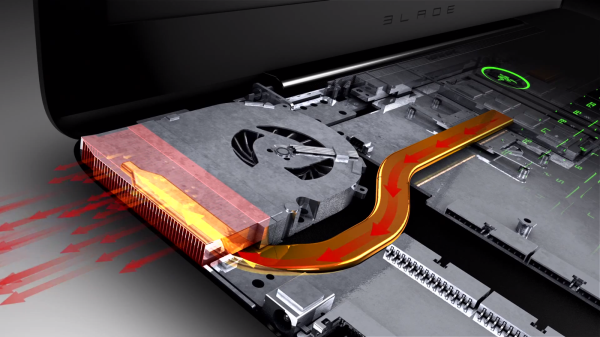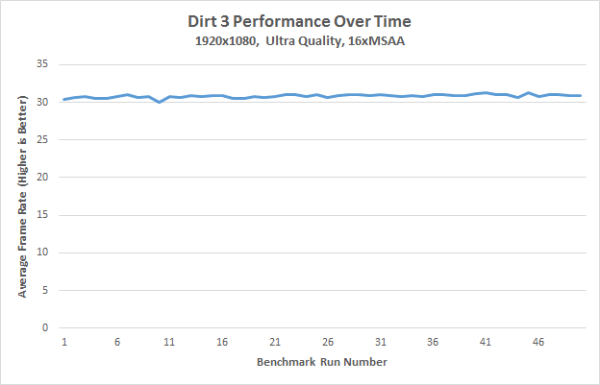The New Razer Blade: Thoroughly Reviewed
by Vivek Gowri on October 3, 2012 5:40 PM ESTRazer Blade (late 2012) - Thermal Design
Razer took a system that was already near the brink of its thermal envelope, tossed about 50% more compute power into it, added 12 watts to the power draw, and tried to still keep it within reasonable operating temperatures. So now we get to see if Razer’s engineering team managed to pull it off.
A quick refresher from last time: the Blade was hot. Damn hot. We saw internal temperatures of 95C on the CPU and 80C on the GPU under loaded conditions, numbers that we were simply not that comfortable with. But it wasn’t just at load; this was a system that got relatively toasty even at idle, where we saw temperatures in the 50-60C range. This resulted in a system that ran hot to the touch (though most of this heat was directed away from areas that are commonly touched like the keyboard and palmrests) and constantly had the fan running, even when bouncing around the internet or YouTube. Put simply: not great.
Thankfully, the redesigned cooling system has helped tremendously, particularly at low load. The system now idles in the 37-42C range, significantly lower than the 55ish it used to go for, and it’s very rare to see the fans spool up until you start gaming. I put it through my typical 100% system load, basically using Furmark 1080p and wPrime 1024M looping to peg both CPU and GPU load at 100% for a sustained period of time to see where temperatures settled. wPrime is multithreaded so with 8 threads it's loading all four cores equally. I saw CPU temperature settle in the 85C range, while GPU temperature maxed out at 90C. It’s still pretty hot, but even at a sustained hour-long clip, I never saw throttling—the GPU core was pegged at 950MHz—and the fan itself was much less intrusive than before.
To put this to the test in a real-world gaming situation, I fired up our DiRT 3 benchmark (it’s built into the game) and ran it fifty times in a row. I tested at our Enthusiast setting, which is 1080p, Ultra High quality, and 4xMSAA, and each run, including cut-scenes, totalled about 2 minutes and 20 seconds, give or take ten seconds—it’s not the exact same clip each time, as AI is typically different, which impacts the race results and elapsed times. That’s essentially two hours of gaming, with a fairly new game running at maximum settings. My performance over time graph ended up being as flat as Wyoming—almost no deviation in performance, beyond random test-to-test variation. I ran a similar test on the MacBook Pro (except with Anand’s OS X Half-Life 2 benchmark) and by run 30, the downward trend was pretty clear. I ran that 40 times, but I went even longer here to see if I could establish any kind of pattern. All I got was a really consistent 30.75fps, give or take one. I was impressed, to say the least.
A quick note—I was unequipped to test fan noise, but I can say that even under full load, the new fans are much quieter than the old fans were even under part loading. The new fans seem to be running at a lower RPM as well, which was no doubt helped by the larger venting; it’s a really big improvement from before.












59 Comments
View All Comments
ahamling27 - Wednesday, October 3, 2012 - link
It was my black Macbook from 2007, only larger and with a weird placement of the trackpad. It's sleek, I'll give them that, but I'd much rather pay for something that's bulky but has more horsepower under the hood. That's all we're really talking about here though, and I'm not willing to choose form over function, not at that price point.danjw - Wednesday, October 3, 2012 - link
Ok, so why bother with a comment? To me it is a good trade off of form factor and functionality. Like Vivek, I would prefer an option for a pure SSD; But it isn't a bad compromise they have gone with.I like the Switchblade to play with as well. Some may find it cumbersome to program, but as a computer programmer, I doubt I will find it so.
Anyway mobile devices are about trade offs, some will fit some peoples styles and others will fit others. it is part of the game.
ahamling27 - Wednesday, October 3, 2012 - link
The point was to start a discussion. I honestly don't see why anyone would pay so much for something when a better spec'd machine can be had for quite a bit less. I understand that it's not easy to cram all that in a rather slim and attractive design, but why should that cost such a premium?Back in 2009 I purchased a Gateway P-7811 FX for 40% of the asking price and it's got a 1920x1200 screen, a 9800m gts, and a dual core 2.26 ghz processor, and that was over 3 years ago! Sure it wasn't .88" thin, and all black, but it wasn't ugly either.
All I'm saying is that for this to be anything but an expensive gimmick, they need to figure out a way to lower their costs.
gelb - Wednesday, October 3, 2012 - link
Well in my opinion, its like this; A Toyota Tacoma cost around 30,000 dollars for a 3.4 liter v6 engine and and a great sleek good looking finish along with a nice attention to detail. Now on the other hand is the around 20,000 dollar Nissan Frontier with a 4.0 liter v6 engine. Now, the Tacoma will give you a lot more features along with nicer finish and machine work to the actual frame and parts, but it lacks the "uumph" the Frontier has with it's 4.0 liter v6 engine. Now another thing that should be taken into account their fuel efficiency. The Tacoma gets a much better fuel efficiency than the Frontier does. So, the Blade in my opinion is the Tacoma and the other brands such as Asus etc. are the Frontier makers. In the Blade, you don't get the same kind of power but you trade it for a better finish/build and sleekness.elhoboloco - Thursday, October 4, 2012 - link
> Toyota> Great design
Pick one.
VivekGowri - Thursday, October 4, 2012 - link
Hahaha. You can make the same argument with the 911 and the Corvette, if that helps. Power and value versus refinement, style, fit and finish, design/build quality, etc.Bob Todd - Thursday, October 4, 2012 - link
Saying the Gateway P-7811 FX wasn't ugly doesn't help your case. It was hideous. I had one for 2 days before returning it for a screen defect. Some people are willing to pay (significantly) more for better materials and build quality. You can get the same CPU/GPU/resolution in a $999 Lenovo Y580. That doesn't make it a better laptop for everyone. One feels premium, the other feels like a tin can. It might not be worth it to you, but not everyone has the same use case and priorities as you. You don't try to build a premium brand (with premium margins) by starting off competing in the hotly contested space between $800-$15000. For me, Vivek was spot on about wanting to ditch caching storage and add IPS at this price point. So while I wouldn't spend $2500 on this, I can absolutely understand others doing so. I'd love to have one, and that's kind of the point from a product perspective.Bob Todd - Thursday, October 4, 2012 - link
If only I could edit...that was supposed to be "basically the same CPU/GPU/resolution", as the Blade obviously has the 3632QM vs. the 3610QM in the Y580.ahamling27 - Thursday, October 4, 2012 - link
The Gateway was far from ugly, but what it looks like is purely subjective and had nothing to do with the point I was trying to make. You actually helped me prove my point with the Lenovo. That's a great laptop there, so why does the Switchblade cost $1500 more?$1500 more for something that "feels premium"? It's a plastic body...
The problem with them making a "premium" product is that they aren't using "premium" parts. They are using middle of the road hardware and calling it "premium". That's what I have a problem with.
ahamling27 - Thursday, October 4, 2012 - link
Whoops, now I'm red in the face, I guess it is made of aluminium , not plastic. +1 Razer, but I'm still standing my point, it woefully overpriced.